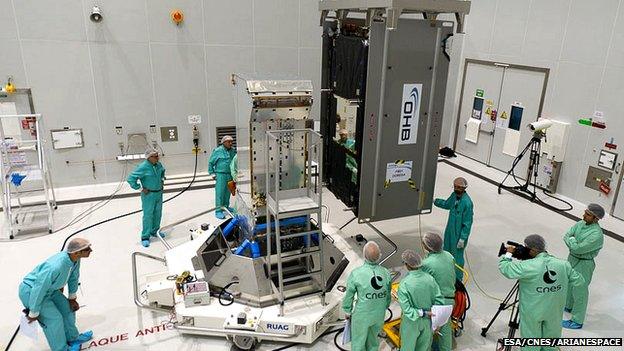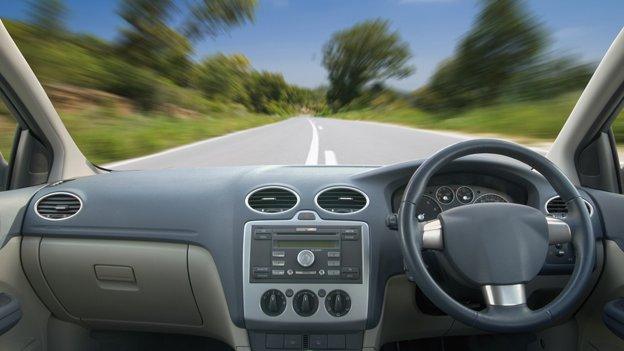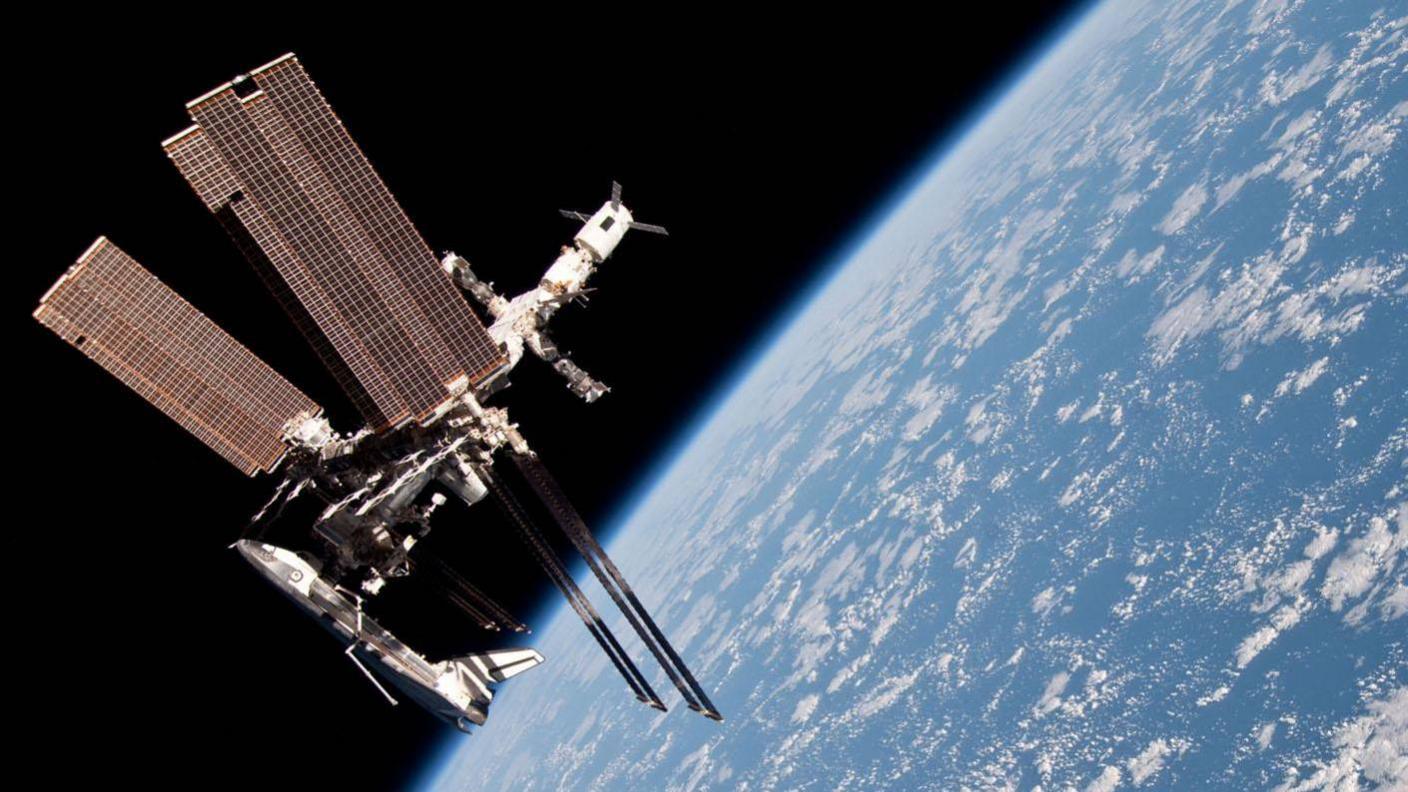Galileo: What does a more accurate sat-nav system mean?
- Published

The Soyuz rocket can carry two Galileo satellites at a time
With the planned launch of two satellites aboard a Soyuz rocket from French Guiana later this month, Europe is pushing ahead with its own satellite-navigation system, known as Galileo.
It promises much great accuracy in locating where we or objects are on the planet and could have a profound effect on how we live our lives.
So far we've used the US GPS (Global Positioning System) which is accurate up to a few metres. Galileo has the potential to offer accuracy up to a few centimetres.
The potential practical benefits of more accurate navigation include driverless cars, more flexible charging systems on toll motorways, more efficient air traffic control, more accurate navigation for ships, and even helping blind people get around cities.
It will allow you to know where you are not just in a street - but even in a building.

Satellite-derived location data is already being used by farmers to help with harvesting

Slovakia's GoSpace was one of the first to use Galileo experimentally for location fixes
Greater accuracy
"Galileo promises to be much more accurate than the US-owned GPS," says Steve Smart, head of the space programme at CGI, the Canadian tech company that has been developing some of Galileo's commercial applications.
It could also help improve capacity on Europe's rail networks.
As many rail signalling systems are still relatively unsophisticated, it means that for safety reasons trains have to be well-separated.
Galileo will give much more accurate real-time read-outs of trains' locations, which should allow operators to run more trains on a particular stretch of track - welcome news for many commuters if that means less overcrowding in the rush hour.

Europe's Galileo satellite network: Key facts

Galileo is Europe's global navigation satellite system, compatible with GPS (US) and Glonass (Russia)
There will be 30 satellites in the network
There will be at least four satellites in view to users
They are in a 14-hour medium Earth orbit (MEO) at 23,222 km (14,429 miles)
Two Giove A and B test satellites launched in 2005 and 2008
Four In-Orbit Validation (IOV) satellites launched in 2011 & 2012
First two Full Operational Capability (FOC) satellites launch expected August 2014
By 2017, 26 satellites will be in orbit, the rest by 2020
Source: European Space Agency

"The commercial service has the potential to improve the performance of existing location services for all user communities," says Carlo des Dorides, executive director of GSA, Europe's satellite navigation agency.
Indeed, driverless cars are being allowed on UK public roads from next year. Last month, Business Secretary Vince Cable said the technology has "very, very large" potential.
Much of this is due to the prospects of more accurate satellite-derived location data.

Driverless cars will depend on accurate sat-nav systems
Escalating costs
The real challenge when it comes to accuracy is built-up areas. Here, in "urban canyons" a user can effectively be hidden from satellites. In such cases, what's known as signal attenuation - or weakening - and signal refraction off surrounding tall buildings, can reduce accuracy.
But in tests, when Galileo has been used alongside GPS and Glonass, it is providing a much more accurate location signal even in urban areas, and is also shortening Time-to-First-Fix (TTFF) - the time it takes for your device to lock on to signals from the satellites.
However, the project is hugely expensive, and Galileo has been plagued by delays and cost over-runs.
Setting up the system and deploying the satellites is costing about 5bn euros (£3.9bn; $6.6bn), a significant sum when budgets across Europe are under pressure.
Yet the bill could rise still further. With annual operating expenditure of 750m euros over 20 years, Galileo's total costs could be more than 20bn euros, says the eurosceptic think-tank, Open Europe., external

Technicians prepare one of the Galileo satellites for this month's launch

Unlike GPS or Glonass, Galileo is civilian-controlled
Growing market
While the idea of Galileo is that it will offer an open signal, which will be free at any point on earth to anyone, there will also be an encrypted service for commercial and security applications.
Even though only a few test satellites are currently in orbit, last month the European Space Agency (Esa) and its partners successfully completed a series of tests of Galileo's encrypted and non-encrypted signal systems.
"Although there are still many steps before the delivery of an operational commercial service, these first tests prove what Galileo can do," says the European Commission's Ignacio Fernandez Hernandez, in charge of developing its commercial service.
This is also a growing market. Esa says it expects the value of businesses relying on satellite navigation to grow by roughly 11% a year, and to be worth 244bn euros by 2020.
"Europe's entrepreneurs, smaller companies and industry can now seize the opportunity to create value-added applications for the downstream market," says Matthias Petschke, director of the European Commission's sat-nav programme.

Galileo has already cost 5bn euros, and the final bill could be much higher
Benefits questioned
But critics caution that the financial benefits to Europe's economy could be less than forecast. After all, Galileo will be competing with the existing US and Russian systems - as well as regional competitors being developed by China, Japan and India.
One of the original strategic drivers for the EU's Galileo project was the American practice during the 1990s of deliberately degrading its own GPS signal for civilian users - meaning reduced accuracies of only hundreds of metres.
Indeed, the EU still highlights the fact that Galileo is a civilian-run operation - unlike America's GPS or Russia's Glonass satellite-navigation systems, both of which are ultimately run by their countries' air forces.
Yet in 2000, the US stopped degrading its GPS signal, and in 2007 said that its latest generation of GPS satellites would not have a facility to allow this to happen. It, too, is pushing ahead with the launch of ever-more-accurate satellites.
So, given these changes, questions have repeatedly been asked as to whether the EU still needs its own sat-nav system. The official answer is still that for Europe to compete effectively in the 21st Century it has to be independent of the US - or anybody else.
"We can't rely on the goodwill of countries like the US and Russia," Esa says.
- Published2 June 2014

- Published9 April 2014

- Published24 January 2014

- Published20 November 2012
